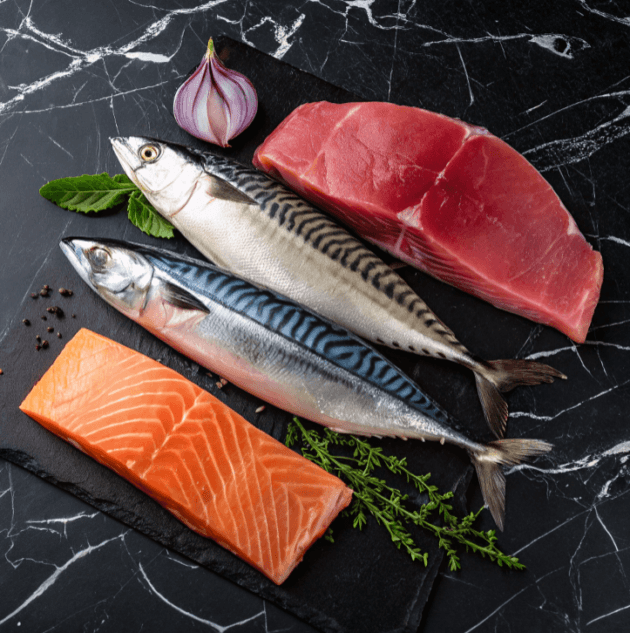Eating raw fish has become increasingly popular worldwide, especially in dishes like sushi, sashimi, ceviche, and poke bowls. However, not all fish are safe to eat raw. Knowing which fish are safe, understanding freezing methods, and learning proper preparation techniques are essential for enjoying raw fish safely.
Why Are Some Fish Safe to Eat Raw?
Not all fish are safe for raw consumption, and understanding the key factors that ensure safety is essential. From parasite risks to freezing methods and handling practices, several aspects determine whether a fish is safe to eat raw.
1. Parasite Risk
One of the biggest concerns with raw fish is the presence of parasites like Anisakis worms and tapeworms. These parasites are more common in freshwater fish, making saltwater fish generally safer for raw consumption.
- Saltwater Fish – Less likely to harbor parasites harmful to humans.
- Freshwater Fish – Higher parasite risks and often require cooking to ensure safety.
This is why most sushi and sashimi dishes feature saltwater fish rather than freshwater varieties.
2. Farm-Raised Fish: Lower Parasite Exposure
Farm-raised fish, such as Atlantic salmon, are often grown in controlled environments that minimize parasite risks. These conditions make them a safer choice for raw dishes.
Examples of Safe Farm-Raised Fish:
- Atlantic Salmon – Popular for sushi due to its controlled breeding.
- Arctic Char – Similar to salmon, often raised with high safety standards.
Farmed fish not only reduce parasite risks but are also inspected for quality and safety. For added flavor and safety, check out How Long Should You Marinate Salmon? before preparing raw dishes.
3. Freezing Standards for Parasite Control
Freezing is one of the most reliable ways to make fish safe for raw consumption. According to the FDA Guide for Parasite Destruction, fish should be:
- Frozen at -4°F (-20°C) for 7 days.
- Or frozen at -31°F (-35°C) for 15 hours.
Freezing at these temperatures kills parasites without affecting the texture or flavor of the fish. However, bacteria are not destroyed by freezing, which means proper handling remains essential.
4. Handling and Storage Practices
Even sushi-grade fish can become unsafe if improperly stored. To ensure safety, follow these practices:
- Immediate Chilling: Store fish at 32°F (0°C) or lower.
- Quick Cleaning: Gut and clean fish as soon as possible to prevent bacterial growth.
- Separate Tools: Use dedicated utensils and cutting boards to prevent cross-contamination.
- Thaw Properly: Always thaw frozen fish in the refrigerator, not at room temperature.
Good handling practices are just as important as freezing when preparing fish for raw consumption.
5. Freshness Matters
The freshness of fish also plays a major role in its safety. Fish intended for raw consumption should:
- Have clear eyes and firm flesh.
- Smell clean without a fishy odor.
- Be stored on ice immediately after being caught.
Even the highest quality fish can become unsafe if mishandled, which is why proper storage and inspection are essential.
Types of Fish Safe to Eat Raw
When choosing fish for raw consumption, it is crucial to understand safety factors. Some fish naturally pose lower risks, while others demand strict handling or are better cooked. Below is a breakdown of the safest options and high-risk fish to avoid.
1. Saltwater Fish (Low Parasite Risk)
Saltwater fish generally carry fewer parasites harmful to humans, making them safer choices for raw consumption. Their mild flavor and firm texture also make them favorites in sushi and sashimi.
- Salmon (Farmed Atlantic Salmon):
- This fish remains a popular choice for sushi due to controlled farming environments that reduce parasite exposure.
- Farmers monitor these environments to ensure safety and quality.
- For tips on preparation and flavor enhancement, explore this Salmon Sushi Guide.
- Tuna (Yellowfin, Bluefin, and Albacore):
- Tuna ranks among the safest fish for raw consumption because it naturally has fewer parasites.
- Its firm flesh and rich flavor make it ideal for sushi rolls and sashimi platters.
- Halibut:
- Many chefs prefer halibut for ceviche and crudo dishes, but it should be flash-frozen to eliminate parasites.
- Its delicate flavor pairs perfectly with citrus marinades.
- Sea Bass:
- Frequently featured in Italian crudo and ceviche, sea bass requires proper freezing before serving raw.
- Its mild flavor complements herbs and lemon juice.
These saltwater fish combine safety and flavor, making them excellent for raw seafood dishes.
2. Shellfish (Handled with Care)
Shellfish can also be enjoyed raw, but they demand careful handling and certified sourcing to prevent foodborne illnesses.
- Scallops:
- Dry-packed scallops taste best when served fresh.
- Their sweet flavor and tender texture make them favorites in crudo and carpaccio.
- Oysters:
- Oysters frequently appear on raw seafood platters and should come from certified waters.
- Shucking them fresh and keeping them on ice ensures freshness.
- Shrimp:
- Although most shrimp are cooked before serving, some sushi-grade shrimp can be eaten raw.
- Freezing and proper handling lower risks.
Because shellfish are highly sensitive to contamination, buyers must always verify certifications and purchase from reliable sources.
3. High-Risk Fish to Avoid Raw
Certain fish pose higher risks due to parasites and bacterial contamination. These species should be cooked thoroughly to ensure safety.
- Freshwater Fish:
- Freshwater fish, such as trout and bass, often carry parasites that can survive in the human body.
- Cooking eliminates these risks, so these species are better suited for grilled or baked dishes.
- Cod and Haddock:
- Flash-freezing may reduce risks, but these fish typically taste better cooked.
- Their delicate texture works well in baked or grilled recipes.
- Mackerel:
- Although mackerel is sometimes served raw, it carries a higher risk of histamine poisoning if stored improperly.
- Many people prefer cooking it to reduce this risk.
Key Considerations
When preparing fish for raw consumption, focus on safety at every step:
- Sourcing: Always buy sushi-grade or certified-safe fish from trusted suppliers.
- Freezing Standards: Confirm that fish has been frozen to FDA standards to eliminate parasites.
- Storage and Handling:
- Keep fish stored at 32°F (0°C) or lower to prevent bacterial growth.
- Use clean tools and dedicated cutting boards to avoid cross-contamination.
- Thaw fish in the refrigerator, not at room temperature.
Key Takeaways
Not all fish are safe to eat raw, so understanding the risks and safety measures is crucial.
- Saltwater fish, like salmon, tuna, and halibut, carry fewer parasites and are widely regarded as safer options.
- Shellfish, including scallops and oysters, require strict handling and certified sourcing.
- Freshwater fish and species like cod and mackerel often carry higher risks and should be cooked thoroughly.
Risks of Eating Raw Fish
Raw fish is widely enjoyed in dishes like sushi, sashimi, and ceviche. However, it also carries certain health risks. Proper handling, freezing techniques, and storage practices can often reduce these risks. Understanding the potential dangers is essential for safe consumption.
1. Parasites
Parasitic infections pose one of the primary risks of eating raw fish. Common parasites include:
- Anisakis worms – Frequently found in marine fish, these worms can cause digestive issues when consumed alive.
- Tapeworms – Often present in freshwater fish, these parasites may lead to nutrient deficiencies and digestive problems.
How to Prevent Parasites:
- Freeze Properly – Freeze fish at -4°F (-20°C) for 7 days or -31°F (-35°C) for 15 hours to eliminate parasites.
- Buy from Trusted Suppliers – Choose fish labeled sushi-grade or sashimi-grade for safety.
- Inspect Visually – Carefully check fish for visible parasites before preparation.
2. Bacterial Contamination
Harmful bacteria in raw fish can cause foodborne illnesses. Some common bacteria include:
- Listeria monocytogenes – Causes nausea, fever, and muscle aches.
- Salmonella – Leads to diarrhea, cramps, and food poisoning.
- Vibrio vulnificus – Found in warm waters, this bacterium may trigger serious infections.
How to Prevent Bacterial Contamination:
- Handle Properly – Clean utensils and surfaces thoroughly before and after use.
- Store at Safe Temperatures – Keep fish at 32°F (0°C) or lower to slow bacterial growth.
- Thaw Safely – Always thaw frozen fish in the refrigerator, not at room temperature.
3. Histamine Poisoning (Scombroid Poisoning)
Improper storage allows histamines to build up in fish such as tuna and mackerel, potentially causing scombroid poisoning. Symptoms include:
- Flushed skin.
- Headaches.
- Tingling sensations.
- Abdominal pain.
How to Prevent Histamine Poisoning:
- Refrigerate Properly – Maintain storage temperatures below 40°F (4°C) at all times.
- Consume Quickly – Eat raw fish as soon as possible after thawing.
- Check Freshness – Inspect fish for spoilage before preparation.
4. Allergic Reactions
Seafood allergies can lead to severe reactions after eating raw fish. Symptoms may include:
- Swelling of the lips and throat.
- Rashes or hives.
- Anaphylaxis in extreme cases.
How to Avoid Allergic Reactions:
- Avoid Raw Fish – Those with known allergies should avoid raw fish entirely.
- Check Ingredients – Review sauces and marinades for hidden allergens.
5. Heavy Metal Contamination
Certain large fish, such as tuna and swordfish, accumulate higher levels of mercury and other toxins. Long-term exposure may result in:
- Neurological damage.
- Kidney problems.
- Developmental issues in pregnant women and children.
How to Minimize Heavy Metal Exposure:
- Choose Smaller Fish – Opt for fish like salmon, mackerel, and sardines, which contain lower mercury levels.
- Limit Portions – Reduce consumption of high-mercury fish to recommended servings per week.
How to Safely Prepare Raw Fish at Home
1. Buy Sushi-Grade Fish
- Always purchase from trusted fishmongers and look for sushi-grade or sashimi-grade labels.
2. Follow Proper Freezing Methods
- Freeze at -4°F (-20°C) for 7 days.
- Alternatively, freeze at -31°F (-35°C) for 15 hours.
3. Handle and Store with Care
- Thaw in the refrigerator—never at room temperature.
- Use separate utensils and cutting boards to prevent cross-contamination.
Popular Dishes Featuring Raw Fish
- Sushi and Sashimi – Japanese favorites with fresh tuna and salmon.
- Ceviche – Latin American dish using citrus juice to “cook” the fish.
- Crudo – Italian-style raw fish served with olive oil, herbs, and citrus.
- Poke Bowls – Hawaiian bowls with marinated raw fish and vegetables.
Tips for Eating Raw Fish at Restaurants
- Ask Questions: Ensure the fish meets FDA freezing standards.
- Check Cleanliness: Observe fresh displays and hygiene practices.
- Look for Certifications: Opt for restaurants with certified seafood suppliers.
Common Myths About Eating Raw Fish
- Myth 1: Lemon juice kills parasites. (Fact: Freezing is the only proven method.)
- Myth 2: Freshwater fish are safe to eat raw. (Fact: Higher parasite risks make them unsafe.)
- Myth 3: Grocery store fish can be eaten raw. (Fact: Only sushi-grade fish are safe.)
FAQs About Eating Raw Fish
Q1: What fish can I eat raw without freezing?
- Tuna and farmed Atlantic salmon are safe without freezing due to low parasite risks.
Q2: Can I eat raw shrimp?
- Yes, but only when labeled safe for raw consumption and handled properly.
Q3: Does lemon juice kill parasites?
- No. It only adds flavor—freezing is required to eliminate parasites.
Q4: Is grocery store fish safe for sushi?
- Only if labeled as sushi-grade and handled properly.
Conclusion
Eating raw fish can be a delightful experience when proper safety guidelines are followed. From sushi and sashimi to ceviche and poke bowls, raw fish offers versatility and nutritional benefits.
For inspiration, try this Salmon Sushi Guide or explore cooked alternatives like Baked Maple Salmon for a safer option.
With the right freezing techniques, sourcing, and handling methods, you can enjoy raw seafood safely and confidently!

